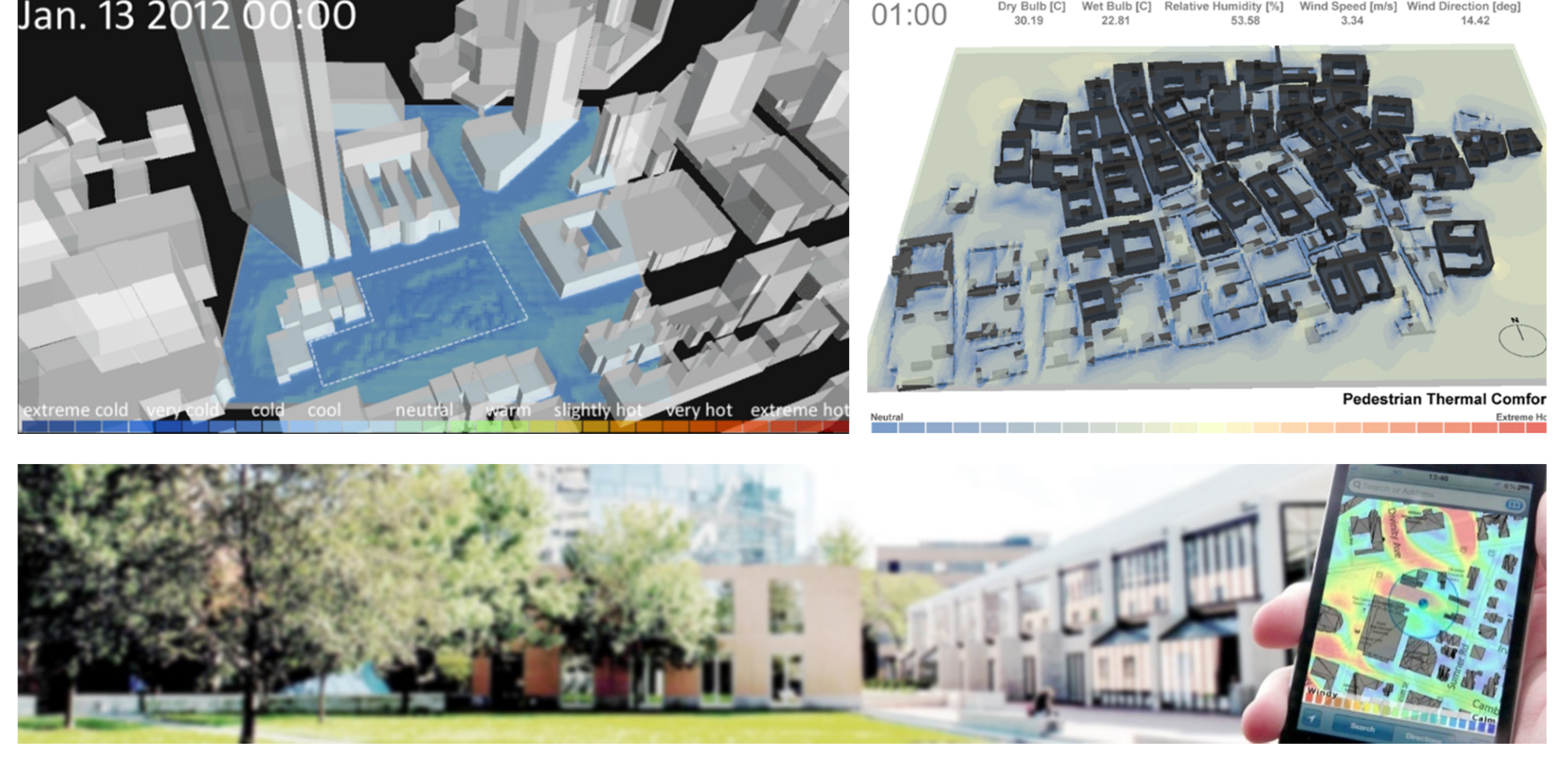CityComfort+

CityComfort+ is a design and planning tool jointly developed at the University of Hong Kong and Harvard University. It applies a physics-based model to assess urban environmental parameters in light of climate change. The tool uses inputs of 3D urban geometries, surface properties, topography and weather data; the output features micro-scale environmental parameters including human perception of thermal comfort, day-lighting, wind speed, solar radiation, air temperature, air quality, and noise, etc.
CityComfort+ has been validated via field studies and results were published in peer-reviewed journals. Currently, the tool has been developed into a software for cluster/grid computing and it can also operate on personal computers via a Graphical User Interface (GUI) Plugin for Rhino.
City Comfort Plus has been specifically designed with transferability in mind, allowing for its application in various cities worldwide. It was originally developed in Boston, and has been applied to Cardiff, Hong Kong, Singapore and other cities and regions.
Download
Students and educators can get free access to CityComfort through the link below:
https://drive.google.com/drive/folders/1RAdeKbyIjRkFGVaXCxwwHKSUj1OZTZI6?usp=sharing
User Guide
For more detailed instructions, please refer to the tutorial below:
CityComfortPlus_UserGuide_2024.pdf
Research Publication
2023
Hao, T., Chang, H., Liang, S., Jones, P., Chan, P. W., Li, L., & Huang, J. (2023). Heat and park attendance: Evidence from “Small data” and “big data” in Hong Kong. Building and Environment, 234, 110123. https://doi.org/10.1016/j.buildenv.2023.110123
Hao, T., Zhao, Q., & Huang, J. (2023). Optimization of tree locations to reduce human heat stress in an urban park. Urban Forestry & Urban Greening, 86, 128017. https://doi.org/10.1016/j.ufug.2023.128017
Peng, Z., Lu, W., Hao, T., Tang, X., Huang, J., & Webster, C. (2023). Cost-aware generative design for urban ‘cool spots’: A random forest-principal component analysis-augmented combinatorial optimization approach. Energy and Buildings, 295, 113317. https://doi.org/10.1016/j.enbuild.2023.113317
2022
Huang, J., Hao, T., Wang, Y., & Jones, P. (2022). A street-scale simulation model for the cooling performance of urban greenery: Evidence from a high-density city. Sustainable Cities and Society, 82, 103908. https://doi.org/10.1016/j.scs.2022.103908
Huang, J., Hao, T., Liu, X., Jones, P., Ou, C., Liang, W., & Liu, F. (2022). Airborne transmission of the delta variant of SARS-COV-2 in an auditorium. Building and Environment, 219, 109212. https://doi.org/10.1016/j.buildenv.2022.109212
Hao, T., Huang, J., He, X., Li, L., & Jones, P. (2022). A machine learning-enhanced design optimizer for urban cooling. Indoor and Built Environment, 32(2), 355–374. https://doi.org/10.1177/1420326×221112857
2021
Hao, T., Huang, J., & Jones, P. (2021). Design optimization of dense urban neighbourhood with computational simulation and genetic algorithm for Improving Outdoor Thermal Environment. Building Simulation Conference Proceedings. https://doi.org/10.26868/25222708.2021.30343
Huang, J., Xu, Y., Jones, P., Li, X., Guo, M., Liu, G., & Ji, J. S. (2021). Building Energy and thermo-hydraulic simulation (BETHS) for district heat system in residential communities: A case of Shenyang, China. Energy and Buildings, 247, 111114. https://doi.org/10.1016/j.enbuild.2021.111114
2020
Huang, J., Jones, P., Zhang, A., Peng, R., Li, X., & Chan, P. (2020). Urban Building Energy and Climate (urbec) simulation: Example application and field evaluation in Sai Ying Pun, Hong Kong. Energy and Buildings, 207, 109580. https://doi.org/10.1016/j.enbuild.2019.109580
Huang, J., Chen, Y., Jones, P., & Hao, T. (2020). Heat stress and outdoor activities in open spaces of public housing estates in Hong Kong: A perspective of the elderly community. Indoor and Built Environment, 31(6), 1447–1463. https://doi.org/10.1177/1420326×20950448
2019
Huang, J., Hao, T., Shan Hou, S., & Jones, P. (2019). Simulation-informed urban design: Improving urban microclimate in real-world practice in a high density city. IOP Conference Series: Earth and Environmental Science, 329(1), 012047. https://doi.org/10.1088/1755-1315/329/1/012047
2016
Huang, J., Zhou, C., Zhuo, Y., Xu, L., & Jiang, Y. (2016). Outdoor thermal environments and activities in Open space: An experiment study in humid subtropical climates. Building and Environment, 103, 238–249. https://doi.org/10.1016/j.buildenv.2016.03.029
Huang, J.; Wang, Y.; Rong, P.; Yang, Y.; Spengler, J.D.; Tomasso, L. (2016). Urban Microclimate & Pedestrian Comfort in Dense Cities. Urban Environment Design, vol.101, Issue 06, pp.266-273
2014
Huang, J., Cedeño-Laurent, J. G., & Spengler, J. D. (2014). CityComfort+: A simulation-based method for predicting mean radiant temperature in dense urban areas. Building and Environment, 80, 84–95. https://doi.org/10.1016/j.buildenv.2014.05.019
FAQ
Q1: I have installed CityComfort+ successfully, but when I launch Rhino, I cannot find the CityComfort+ toolbar and need to repeat the installation again, what should I do?
A1: Please click the Options under the Tool menu bar, select Tollbars, and right click default and select Save. Then click OK button.
Q2: I could not load the CityComfort+, and a pop-up window said that the plugin has been locked.
A2: Please right click Rhino and check the file property to change the plugin setting in Rhino.
Q3: The weather file could not be loaded successfully.
A3: Please check that if you have already created a new project before.
Q4: CityComfort+ does not respond and request me to set up the value of x and y axis after I selected the boundary.
A4: Please check up layers in your model, if there are other objects in your Layer boundary, delete them except the curve of analysis range. Otherwise, when CityComfort+ request you to select a range to analysis, make sure you do select a curve, not a surface. (Hint: Since sometimes curves and surfaces will overlap with each other in rhino, you may right click Layer boundary and select objects, then you can select the analysis range directly.
Q5: When I click the Calculate button, waring window pops up with the text “Current layer cannot be turned off or locked” and stop the analysis process.
A5: Please turn on or unlock the original layers and groups in your rhino model and re-set up your model to calculate, CityComfort+ need to read information from them.
Q6: During the calculating process of CityComfort+, the radiance does not work.
A6: Please disable the anti-virus software or firewall for a while.
Contact us
We appreciate any feedback. Please feel free to contact us at: shdc@hku.hk
